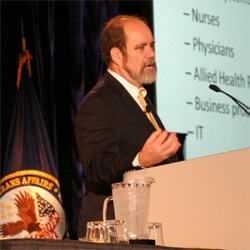Conference Underway with Full Attendance
<< back to Simulation National Leadership Conference 2010 Home page

Tues. 9/14/2010 - AM
After the Simulation National Leadership Conference opening remarks by SimLEARN Program Director Dr. Paula Molloy, Dr. Robert Jesse, Principle Deputy Under Secretary for Health, spoke to the audience of VHA leaders from around the country. Dr. Jesse framed the opening of his presentation against the historical model of medical education: See one, do one, teach one. Traditionally students would observe a medical procedure, they would attempt it, and if successful, they would then teach it to others. Unfortunately, this was not in the best interest of the patients. But several things are driving change in medical education. The new reality involves shorter training cycles, patients' rights, and a greater focus on quality and outcomes.
Dr. Jesse outlined reasons for why simulation presents the most viable solution for medical education in this new reality.
- New simulation techniques (learning in context, team training, standardized patients, etc.)
- New simulation technologies (high fidelity mannequins, task trainers, etc.)
- Broad support for simulation (government, physicians, nurses, allied health, IT, etc)
- Rapid adoption due to effectiveness (reinforced concepts, debriefing, dynamic training opportunities, etc.)
Dr. Jesse explored why the VA should adopt simulation as a program for medical education. He cited the need for consistency across the spectrum of VA systems, preventing duplication of efforts, and the need for sustainability in educational initiatives. SimLEARN is a direct result of these ideas. In fact, one of the main goals of SimLEARN is to become a national leader in simulation based medical education (SBME). "The VA wants to be ahead of the curve" and the VA will always be present at the table when simulation developments are going on, Dr. Jesse remarked. "SimLEARN is how we will do this."
In closing, Dr. Jesse encouraged the leadership to provide input on what they think should be prioritized in the VA's proactively toward SBME, urging "it's a tremendous opportunity for all of us."
SimLEARN Program Director Dr. Paula Molloy took a deeper look into the goals of the SimLEARN program and its pillars: process modeling, education, training, and research. Drs. William McGaghie, Elizabeth Hunt, Geoff Lighthall and Kyle Harrison finished the morning sessions for the VHA leaders, presenting research and techniques promoting simulation.



















